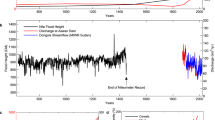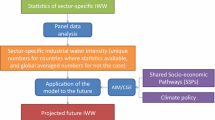Abstract
Higher economic growth would require higher agricultural growth and higher energy production coupled with urbanization. There are four major sources of demand for water. These are from (1) Agriculture, (2) Residential, (3) Industry, (4) Power Generation. However, Agriculture and Power are major water-using sectors. To understand the competing demands for water from various sectors and the water deficit that may appear in the future and economic growth increases an input–output dynamic optimisation model for a consistent projection of water demand and supply. Total water demand in 2015 is estimated to be at 868 bcm. Water demand increases by nearly 30–40% by 2030 and is almost double by 2050 compared to the levels in 2015. Low carbon policies reduce water demand by 1 billion cubic metre and 7 billion cubic metre in 2050 through INDC and Ambitious policies, respectively. The demand for water from Power of course decreases as we assume MOEFCC guidelines for water conservation in power plants are adhered to. In the scenario of a policy failure, water withdrawal demand from power sector would be nearly 12 times in 2030 and nearly 20 times in 2050.
Access this chapter
Tax calculation will be finalised at checkout
Purchases are for personal use only
Similar content being viewed by others
References
Brooke, A., Kendrick, D., Meerhaus, A. (1998). GAMS—A User’s Guide. The Scientific Press. Redwood City.
Centre for Science and Environment [CSE]. (2004, February). Not a Non-Issue. Down to Earth, 12(19).
Parikh, J., & Ghosh, P. (2009). Energy technology alternatives for India till 2030. International Journal of Energy Sector Management, 3(3), 233–250.
Pradhan, B. K., Saluja, M. R., & Sharma, A. K. (2013). Institute of economic growth. Working paper_325.
Shaban, A., & Sharma, R. N. (2007, June 9). Water consumption patterns in domestic households in major cities. Economic and Political Weekly.
Stone, R. (1954). Linear expenditure systems and demand analysis: An application to the pattern of British demand. The Economic Journal, 64(255), 511–527.
Swamy, G., & Binswanger, H. P. (1983). Flexible consumer demand systems and linear estimation: Food in India. American Journal of Agricultural Economics, 65(4), 675–684.
Urban, F. R. M. J., Benders, R. M. J., & Moll, H. C. (2007). Modelling energy systems for developing countries. Energy policy, 35, 3473–3482.
Author information
Authors and Affiliations
Corresponding author
Editor information
Editors and Affiliations
Appendices
Annexure 1
Structure of the Model
The IRADe–IAM model is a multi-sectoral, inter-temporal dynamic optimisation model that is bottom-up in the sense that it includes alternative technology options, and top-down in the sense that it covers the whole macroeconomy (similar to Parikh & Ghosh, 2009) and captures the characteristics considered essential by Urban et al. (2007) for models of developing countries. The model is set up in an activity analysis framework and is solved as a linear programming problem using the GAMS programme (Brooke et al., 1998).
The model maximises present discounted value of the total sum of private consumption over the planning period using a real discount rate of 4% subject to various macroeconomic, technological and resource constraints. It uses the Social Accounting Matrix (SAM) for the year 2007–2008 (estimated by Pradhan et al. [2013]) to represent the whole economy and the sectoral interlinkages. The SAM used in the model is aggregated into 25 commodities and 38 production activities. The model ensures that demand and supply balance in the optimal path for each commodity for each period.
where, Yi,t denotes output and Mi,t denotes imports, Ci,t denotes Private consumption, Gi,t denotes Government consumption, Zit is vector of investment goods, IOi,t denotes Intermediate demand and exports are denoted by Ei,t. Intermediate demand (IOi,t) is determined using the Input–output coefficients from the SAM.
The private household consumption is disaggregated into ten expenditure classes each for urban and rural areas. The per capita household demand function of each commodity by each consumer class is empirically estimated as a Linear Expenditure System (Stone, 1954) based on an underlying common nonlinear expenditure system (Swamy et al., 1983).
-
where, Ciht = per capita consumption of the ith commodity by the hth household group in tth time period,
-
αih = minimum per capita consumption of the ith commodity by the hth household,
-
βih ih = share of the ith commodity in the supernumerary expenditure (total per capita expenditure less the expenditure for minimum consumption) of the hth household and
-
Eht = Total per capita consumption expenditure of the hth household.
The total number of people in each expenditure class is projected using an estimated log-normal distribution for a given level of total per capita consumption. As incomes rise, per capita consumption increases, which results in people moving from lower expenditure classes to higher classes and adopting the consumption patterns of the higher expenditure classes. This is particularly relevant for energy commodities as with higher income levels people adopt more energy-intensive lifestyles for mobility, electricity and petroleum products. The Linear Expenditure System and the log-normal distribution together provide the estimate of Ci,t.
The output of any production activity Xj,t is constrained by available capital stock in the activity. As incremental capital output ratio, ICOR, changes due to technical progress incremental output is related to incremental capital stock.
-
where, Xj,t = domestic output of the jth sector at time t, Kj,t = capital of the jth sector at time t and
-
ICORj,t = incremental capital output ratio of the jth sector in period t.
The total output of a commodity is the sum of the output of all production activities that produce that commodity. Thus Yi,t = Uij*Xjt where Uij is a matrix with a entry of 1 if jth sector produces the ith commodity and zero otherwise.
Capital stock in sector j at time t depends upon the rate of depreciation, and investment at time t.
where DEL(J) is the rate of depreciation in sector j, which is exogenous, and Ij,t is the investment in sector j.
Aggregate investment resource available in the economy depends on aggregate domestic investible resources (domestic savings determined by the marginal savings rate) and foreign investments in the economy (net capital inflow).
Investment goods, are identified separately from other commodities and are also allocated to different sectors as fixed proportions Pi,j (which reflect the share of ith capital good in the jth sector) of the total investment (Ii,t) in jth sector at time t subject to the availability of investment goods.
where, Zi,t = demand of commodity i for investment at time t, VAt = value added at time t, S = exogenously specified maximum marginal savings ratio, Z0 = investment in the base year (2007–2008).
The foreign investments in the economy (net capital inflow) are modelled as a positive but decreasing function of GDP (value added) to allow for developing economies to reduce their reliance on foreign investments over time with development as shown in Eq. 3.7.
where FTt = foreign investment at time t.
The balance of payment constraint requires that the foreign exchange earnings through net capital inflows, FTt and total export earnings are used to meet the foreign exchange requirement from the total import bill. The balance of payment constraint is imposed on the model solution using Eq. 3.8. Trade, exports and imports are endogenous to the model. Upper and lower limits on trade levels are exogenously specified for the model to optimise export and import levels within a reasonable range.
The model also imposes monotonicity constraints on outputs and per capita consumption to simulate a smoother pathway. Resource constraints as incorporated for fossil fuel coal, crude oil and natural gas.
Overall, the model’s projections for commodity demand and production are sectorally consistent and it satisfies all macroeconomic relationships. This feature helps the model to assess the energy economy and resource linkages in a more consistent manner and hence provides a more consistent assessment of the environmental GHG emissions due to activities in the economy. The IRADe–IAM Model is thus able to give a detailed and comprehensive picture of feasible production levels for each sector given the availability of a scarce resource for which all sectors have a competing demand. In this case the constrained resource is water and the IRADe–IAM model can be used to make an assessment for the feasible levels for agricultural and energy sector growth given the water resources available in India and the kind of water conservation strategy required to optimise growth.
The IRADe–Integrated Assessment Model (IRADe–IAM) was used to assess the water demand for power sector in India and the impact of energy efficiency and water use efficiency measures in power sector.
Annexure 2
See Table 3.20
Rights and permissions
Copyright information
© 2023 The Author(s), under exclusive license to Springer Nature Singapore Pte Ltd.
About this chapter
Cite this chapter
Ghosh, P.P. (2023). Projection of Water Demand in India in a Macroeconomic Consistency Framework Incorporating the Food, Water and Energy Nexus. In: Tiwari, P., Parikh, K. (eds) Axes of Sustainable Development and Growth in India. Sustainable Development Goals Series. Palgrave Macmillan, Singapore. https://doi.org/10.1007/978-981-19-9756-3_3
Download citation
DOI: https://doi.org/10.1007/978-981-19-9756-3_3
Published:
Publisher Name: Palgrave Macmillan, Singapore
Print ISBN: 978-981-19-9755-6
Online ISBN: 978-981-19-9756-3
eBook Packages: Economics and FinanceEconomics and Finance (R0)




